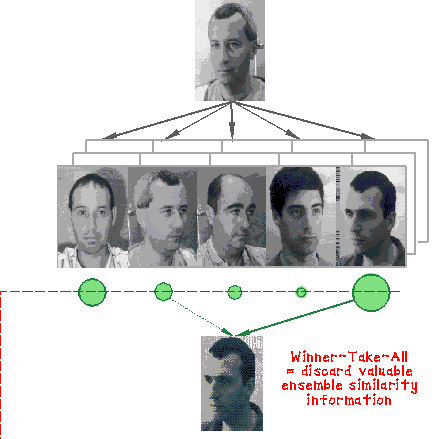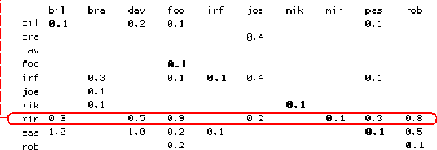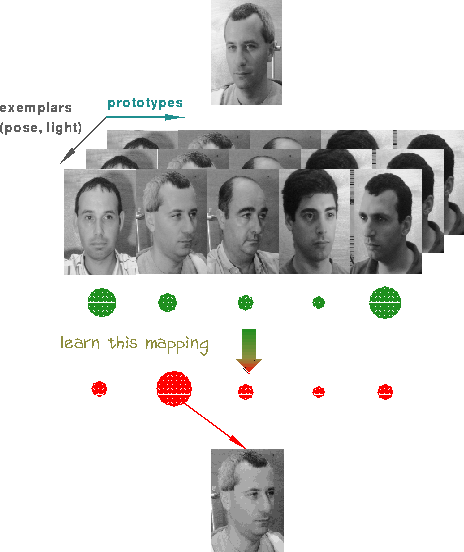


Next: Discussion
Up: Why Have Lateral Connections
Previous: Physiology of Association
Any recognition scheme that purports to output a single object label
must include a decision stage where the label is selected among the
candidates put forward by the preceding stage. A mechanism that
implements this decision (which amounts to a winner-take-all, or WTA,
operation) constitutes a switch from a feedforward to a lateral mode
of information processing, simply because the candidate labels (i.e.,
object representations), are likely to reside at the same processing
level. Not surprisingly, explicit distributed implementations of the
WTA operation typically rely on lateral connections among units that
enjoy equal status in some processing hierarchy
[51].
Recently, a scheme for object representation and classification that
is, in a sense, the conceptual opposite of WTA, has been put forward
under the name Chorus of Prototypes [9]. This two-stage scheme employs vectors of
first-stage distances to a small number of reference objects to span
the second-stage representation space. In this manner, a
low-dimensional representation space for objects is built over a
high-dimensional space of primitive features. Recurring stable
patterns of primitive features, which are expected to correspond to
persistent objects, are represented explicitly, and constitute the
prototypes that span the object space. Each persistent prototype may
be represented by a set of detectors, implemented by RF-like
mechanisms tuned to a number of the object's views; these may be
constructed in a self-organizing fashion following exposure to the
object, as described in the Emergence of ... section. In distinction to
the persistent entities, rare or ephemeral patterns of primitive
features are represented implicitly, by the distributed activity they
induce in the prototype detectors. The latter must respond in a graded
rather than all-or-none fashion; the ratio between the actual and the
peak activity of a detector then may be interpreted as a correlate of
the distance between the current input and the preferred pattern for
that detector.
[9]. This two-stage scheme employs vectors of
first-stage distances to a small number of reference objects to span
the second-stage representation space. In this manner, a
low-dimensional representation space for objects is built over a
high-dimensional space of primitive features. Recurring stable
patterns of primitive features, which are expected to correspond to
persistent objects, are represented explicitly, and constitute the
prototypes that span the object space. Each persistent prototype may
be represented by a set of detectors, implemented by RF-like
mechanisms tuned to a number of the object's views; these may be
constructed in a self-organizing fashion following exposure to the
object, as described in the Emergence of ... section. In distinction to
the persistent entities, rare or ephemeral patterns of primitive
features are represented implicitly, by the distributed activity they
induce in the prototype detectors. The latter must respond in a graded
rather than all-or-none fashion; the ratio between the actual and the
peak activity of a detector then may be interpreted as a correlate of
the distance between the current input and the preferred pattern for
that detector.
 |
 |
Figure 8: (click on the image to view a larger version) Against WTA. A typical
approach to recognition, say, of human faces, calls for the
storage of object-specific information, which is compared with the
current input in an attempt to find the best match. The object
whose representation wins (i.e., results in the best match) is
proclaimed to have been recognized in the input. As indicated by
the excerpt from a confusion table, borrowed from a real
face-recognition system
[12],
a number of contenders (object-specific units) are usually
involved in any such competition. Suppressing these and letting
the winner take all is equivalent to discarding valuable
ensemble information inherent in the pattern of similarities
between the input and the contender units (see
the Lateral Comparisons ... section).
The relationship between Chorus and the issue of lateral connections
may be clarified by the following line of reasoning. The computational
basis of representation by the activities of prototypical-object
detectors is simultaneous response of several such detectors to any
given input (most of these will respond, if at all, at a fraction of
their maximal output level). As pointed out above, the response of a
detector thus constitutes a representation of the distance between the
current input and the optimal input for that detector, with the
distance being computed in a representation space common to all the
detectors. If this representation space is mapped onto the 2D surface
of the cortex, e.g. in the manner resembling the columnar functional
structure of area IT in the monkey, reported by Tanaka's group
[15,41,42,43], then
lateral spread of activation between columns may support the
computation of the representation-space distances. Moreover,
long-range cortico-cortical connections may endow the representation
space with additional structure, created by fiat as a result of
``random'' associations between items that are not necessarily close
neighbors in the original space.
In addition to learning by creating lateral associations, a system
based on the Chorus principle can also learn by extending its
repertoire of persistent features. A permanent record of the
activation of a certain pattern of first-stage feature detectors may
be created on a higher level, by assigning a higher-order detector
unit to represent that pattern (this corresponds to the creation of a
persistent representation instead of an ephemeral one). The resulting
system derived from Chorus becomes essentially isomorphic to the NMR
model described in the Emergence of ... section; an important distinction
is that it aims at classification (making sense of multiple objects),
rather than recognition (making sense of multiple views of the same
object).

Figure 9: Chorus. To exploit the
ensemble similarity information, the mapping from the responses of
individual recognizers to face identity can be learned from
examples. Parallels between this scheme and multiple-view
representations, and the possible involvement of lateral
connections in its implementation, are discussed in
the Lateral Comparisons ... section.



Next: Discussion
Up: Why Have Lateral Connections
Previous: Physiology of Association
 [9]. This two-stage scheme employs vectors of
first-stage distances to a small number of reference objects to span
the second-stage representation space. In this manner, a
low-dimensional representation space for objects is built over a
high-dimensional space of primitive features. Recurring stable
patterns of primitive features, which are expected to correspond to
persistent objects, are represented explicitly, and constitute the
prototypes that span the object space. Each persistent prototype may
be represented by a set of detectors, implemented by RF-like
mechanisms tuned to a number of the object's views; these may be
constructed in a self-organizing fashion following exposure to the
object, as described in the Emergence of ... section. In distinction to
the persistent entities, rare or ephemeral patterns of primitive
features are represented implicitly, by the distributed activity they
induce in the prototype detectors. The latter must respond in a graded
rather than all-or-none fashion; the ratio between the actual and the
peak activity of a detector then may be interpreted as a correlate of
the distance between the current input and the preferred pattern for
that detector.
[9]. This two-stage scheme employs vectors of
first-stage distances to a small number of reference objects to span
the second-stage representation space. In this manner, a
low-dimensional representation space for objects is built over a
high-dimensional space of primitive features. Recurring stable
patterns of primitive features, which are expected to correspond to
persistent objects, are represented explicitly, and constitute the
prototypes that span the object space. Each persistent prototype may
be represented by a set of detectors, implemented by RF-like
mechanisms tuned to a number of the object's views; these may be
constructed in a self-organizing fashion following exposure to the
object, as described in the Emergence of ... section. In distinction to
the persistent entities, rare or ephemeral patterns of primitive
features are represented implicitly, by the distributed activity they
induce in the prototype detectors. The latter must respond in a graded
rather than all-or-none fashion; the ratio between the actual and the
peak activity of a detector then may be interpreted as a correlate of
the distance between the current input and the preferred pattern for
that detector.





